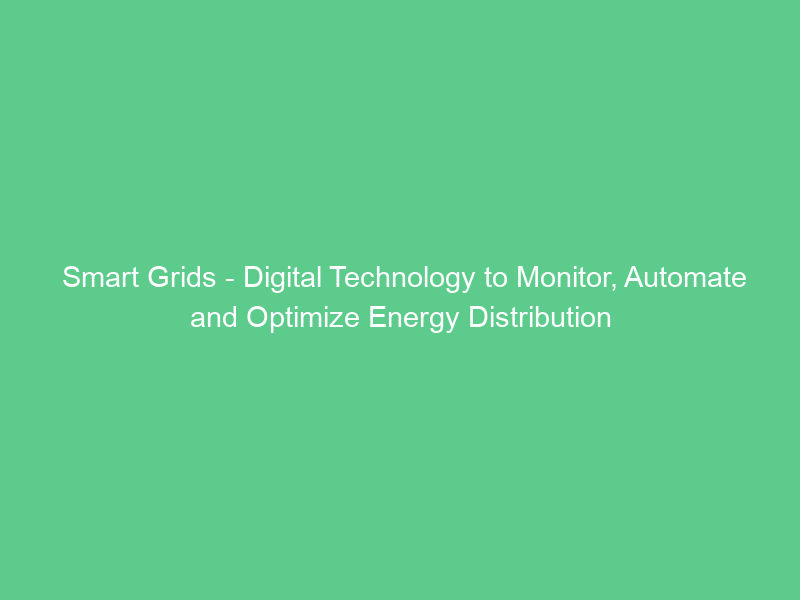Smart grids use digital technology to monitor, automate and optimize energy distribution systems. These systems help prevent outages while simultaneously lowering operational costs while supporting renewable sources like solar and wind.
Intelligence appliances like dishwashers can be programmed to run at certain times of day, reducing demand and price spikes while helping save on bills and promoting a healthier planet.
1. Real-time Monitoring and Control
Real-time monitoring and control capabilities are vitally important to power grids. Smart grids can detect spikes in energy demand, helping reduce usage costs. Furthermore, they help mitigate outages by isolating affected areas automatically.
Smart grids also facilitate communication between energy suppliers (their energy price) and consumers, empowering the latter to make strategic decisions about appliance usage. For example, smart grids could automatically synchronize low priority home devices like dishwashers to run at optimal times of day when electricity prices are lowest – drastically cutting utility bills and carbon emissions while simultaneously helping prosumers maximize renewable energy production from solar panels – leading to greater energy efficiency and sustainability overall.
2. Decentralized Energy Generation
As energy needs continue to increase, many cities are searching for alternative power sources. Traditional centralized power plants may be straightforward and affordable; however, they lack reliability or flexibility that other power sources could offer.
Smart grid technology can identify variations in current and voltage, enabling it to automatically reroute energy when necessary. PMUs (pulse measurement units) take 30-60 measurements every second and respond within seconds if an excessive current causes damage.
Smart grid infrastructure also enables consumers to act as micro-generators by employing control systems and net metering to incorporate roof top solar generation into the grid, providing peak load management and energy efficiency by balancing supply and demand, which ultimately lowers energy prices for everyone.
3. Enhanced Reliability and Resilience
The power grid must maintain an ideal equilibrium between energy supply and demand. If not enough electricity enters, its frequency drops and some power plants could disconnect – leading to blackout. Smart grid technologies help avoid such potential issues by monitoring real-time surges, losses and waste that threaten to undermine its operation.
Smart grids leverage advanced analytics and automation to quickly detect problems in distribution systems and proactively address them, increasing reliability and resilience overall. Furthermore, energy suppliers gain access to information on energy consumption that allows them to improve their commercial offerings; electric vehicle (EV) owners can even receive real time pricing information so that they can charge their cars when electricity prices are cheapest.
4. Increased Energy Efficiency
As energy demand and renewable sources like solar and wind continue to expand, we require systems that can efficiently manage these unpredictable sources. Smart grids use digital technology to monitor, automate, and optimize electricity systems – guaranteeing the most sustainable and effective methods for handling our energy supplies.
This allows for improved load balancing to lower costs for all on the grid and minimize electricity losses from transmission over long distances between power plants and population centers.
Smart grids also have the capacity to detect power surges or any incidents that impact electrical frequency, helping avoid disconnections from power plants or technical energy loss issues that could cause blackouts.
5. Reduced Outages
Utilizing advanced technology, Smart Grid systems detect issues and respond automatically. This minimizes outages while decreasing costs associated with their restoration.
Sensors and automation devices monitor voltage, current, load capacity and communication channels between each other via networking devices – sending this data back to power generation and consumption devices to optimize power distribution.
Smart grids can prioritize emergency services during an outage and use customer-owned energy generators for sustainable power production; combined with distributed energy resources, this helps promote sustainable electricity generation while decreasing transmission losses–which typically account for about 8 percent of total electricity generation.
Smart Grids also enable utilities to quickly identify and isolate issues so they can dispatch a crew immediately – improving reliability and reducing outages, while simultaneously optimizing system-wide efficiency by limiting unnecessary energy use and helping balance supply with demand more easily.

